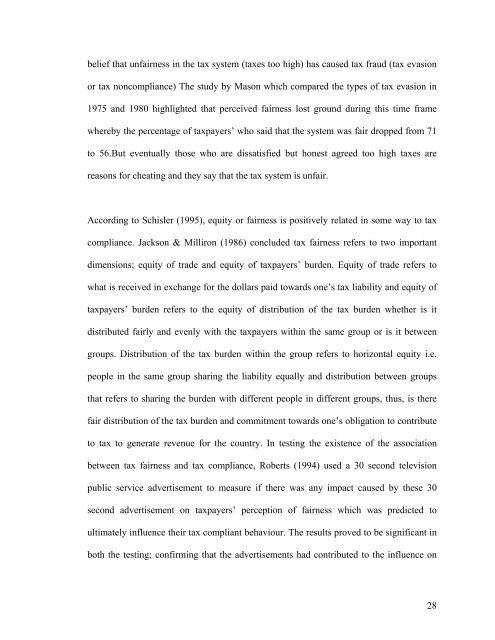1 CHAPTER 1: INTRODUCTION 1.0 Chapter ... - DSpace@UM
1 CHAPTER 1: INTRODUCTION 1.0 Chapter ... - DSpace@UM
1 CHAPTER 1: INTRODUCTION 1.0 Chapter ... - DSpace@UM
You also want an ePaper? Increase the reach of your titles
YUMPU automatically turns print PDFs into web optimized ePapers that Google loves.
elief that unfairness in the tax system (taxes too high) has caused tax fraud (tax evasionor tax noncompliance) The study by Mason which compared the types of tax evasion in1975 and 1980 highlighted that perceived fairness lost ground during this time framewhereby the percentage of taxpayers’ who said that the system was fair dropped from 71to 56.But eventually those who are dissatisfied but honest agreed too high taxes arereasons for cheating and they say that the tax system is unfair.According to Schisler (1995), equity or fairness is positively related in some way to taxcompliance. Jackson & Milliron (1986) concluded tax fairness refers to two importantdimensions; equity of trade and equity of taxpayers’ burden. Equity of trade refers towhat is received in exchange for the dollars paid towards one’s tax liability and equity oftaxpayers’ burden refers to the equity of distribution of the tax burden whether is itdistributed fairly and evenly with the taxpayers within the same group or is it betweengroups. Distribution of the tax burden within the group refers to horizontal equity i.e.people in the same group sharing the liability equally and distribution between groupsthat refers to sharing the burden with different people in different groups, thus, is therefair distribution of the tax burden and commitment towards one’s obligation to contributeto tax to generate revenue for the country. In testing the existence of the associationbetween tax fairness and tax compliance, Roberts (1994) used a 30 second televisionpublic service advertisement to measure if there was any impact caused by these 30second advertisement on taxpayers’ perception of fairness which was predicted toultimately influence their tax compliant behaviour. The results proved to be significant inboth the testing; confirming that the advertisements had contributed to the influence on28
















